Physical Address
304 North Cardinal St.
Dorchester Center, MA 02124
A 55-year-old female with a recent history of interstitial lung disease reported weakness in her arms and legs. Recently she had noticed that she could not climb the 10 steps up from her basement. She had also developed difficulty picking up jars from the shelves of tall cabinets, as well as an inability to keep her hands over her head to brush her hair. She had no problems with swallowing. Her examination was significant for bilateral weakness of her hip flexors (iliopsoas), deltoids, biceps, and triceps. Muscle stretch reflexes were diminished but present. Sensory examination was normal.
Serum creatine kinase (CK) was increased to 1200 U/L (six times normal). Electromyography (EMG) demonstrated normal nerve conduction studies. However, needle examination was abnormal, with large numbers of short-duration, low-amplitude, polyphasic motor unit potentials associated with scattered fibrillation potentials and complex repetitive discharges.
Comment: This patient's presentation is typical for a myopathic process with the clinical picture of evolving proximal weakness, elevated serum CK, and abnormal EMG.
The common acquired myopathies are classified into those having a primary inflammatory process, an underlying endocrinopathy, a toxic pathophysiology, or an underlying associated systemic disorder. Much less commonly, a few infectious agents, such as trichinosis, may lead to a primary myopathy. Myopathies typically present with symmetric symptoms and signs of muscle weakness affecting the proximal limbs and paraspinal musculature ( Fig. 71.1 ). Asymmetric, distal, generalized, or regional patterns of weakness also occur in certain distinct myopathies such as sporadic inclusion body myositis (sIBM). Less commonly, ventilatory muscles or cardiac muscles are primarily affected. Myopathies occasionally present with periodic weakness, exercise-induced muscle pain, or stiffness.
Certain other neuromuscular disorders may mimic myopathies. Myopathies are included in the same differential diagnosis as neuromuscular transmission disorders, motor neuron disease, and rarely chronic inflammatory demyelinating polyneuropathies (CIDPs). Muscle stretch reflexes are generally normal or reduced, and sensation is usually unaffected in primary myopathies. The presence of certain distinguishing clinical features may help in the diagnosis of a myopathy. These include the pattern of weakness (e.g., presence of ptosis, ophthalmoparesis, ventilatory muscle weakness, scapular winging, head drop, symmetry, and proximal vs. distal weakness) or other clinical features (e.g., contractures, skeletal dysmorphisms, calf hypertrophy, myotonia, cardiac involvement, or subtle to marked dermatologic changes). Another very important diagnostic determinant is an assessment of the clinical temporal profile (e.g., the rate of progression), any history of a relapsing (periodic) weakness, diurnal variation, and symptoms that occur only with exertion. Other important factors include genetic predisposition, medication and toxin exposure, and other organ system involvement.
Patients who present with symptoms of myalgia and muscle weakness with a normal muscle strength examination and with normal or mildly elevated serum creatine kinase (CK) levels are common in clinical practice. Such patients are diagnostically and therapeutically challenging. Definable myopathic disorders are uncommon in patients who present with muscle pain, fatigue, or exercise intolerance in the absence of objective clinical, laboratory, or electrophysiologic abnormalities.
Serum CK is characteristically increased in many myopathies; this may vary from a 2- to 50-fold increase, although in most myopathies CKs are usually in the 500–5000 IU/mL range ( Fig. 71.2 ). When this enzyme is abnormally elevated, its serum levels do not closely parallel disease severity or activity. Serum aldolase levels are also frequently elevated in myopathies; its increase generally parallels the increase in CK; therefore many clinical neuromuscular specialists do not routinely order an aldolase level. CK levels may be helpful in distinguishing certain muscle conditions. For instance, CK in necrotizing myopathy is typically significantly elevated (>10× normal). CK is typically elevated (up to 5–10× normal) in sIBM but may be normal.
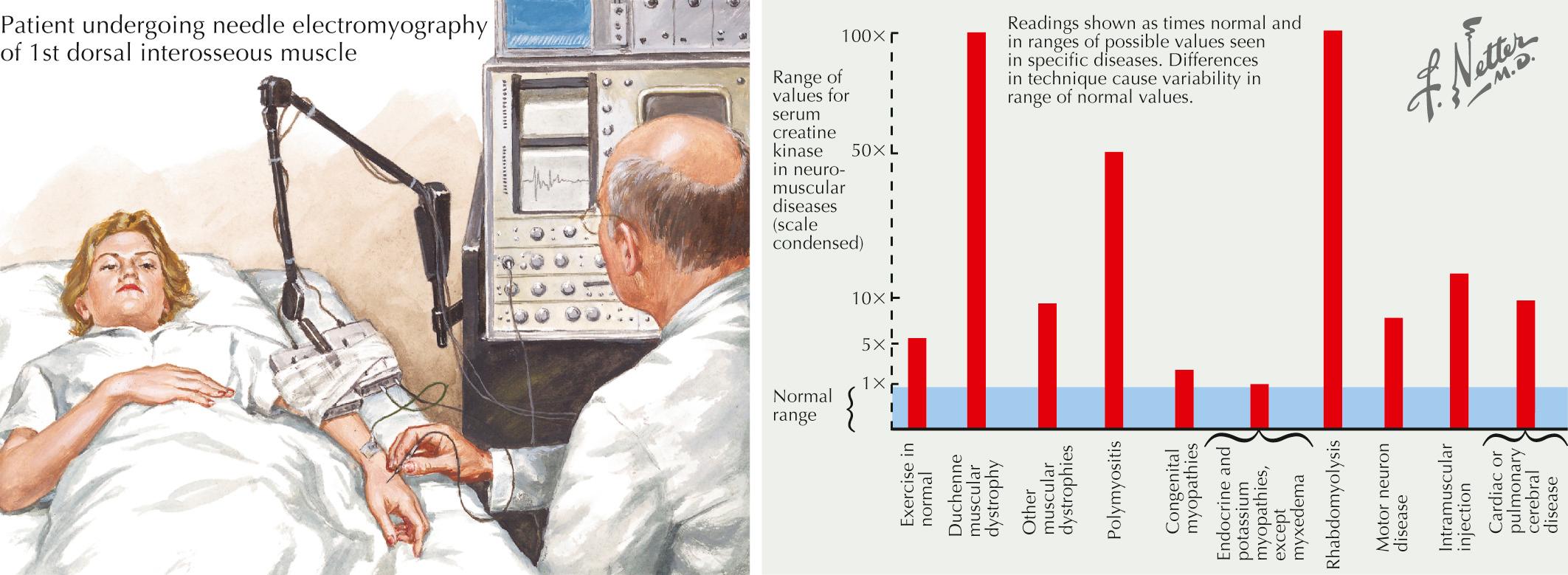
An increased CK level is a nonspecific finding. Other motor unit disorders (amyotrophic lateral sclerosis or spinal muscular atrophy) and systemic processes (particularly myxedema) are commonly associated with increased CK of two to five times normal levels. Conversely, serum CK can be normal in certain patients with dermatomyositis (DM) and sIBM. Certain demographic groups tend to have higher CKs, and CK tends to be slightly higher in men than women.
Patients with persistently increased CK levels, sometimes associated with muscle pain but without clinically demonstrable weakness, family history, or exposure to potentially myotoxic substances, are classified as having hyperCKemia. Despite thorough clinical and laboratory examination, it is often difficult to assign a specific pathophysiologic mechanism to this finding. Patients with hyperCKemia are at increased risk of malignant hyperthermia, and they need to be aware of this rare complication with certain anesthetic agents.
Serum aspartate and alanine aminotransferases (AST and ALT) are frequently elevated in many myopathies because these enzymes are released by diseased muscle. Rarely, some patients with clinically unsuspected myopathies undergo unnecessary evaluation for liver disease when AST and ALT elevations are found and CK has not been checked. Other liver function studies (e.g., gamma glutamyl transpeptidase and prothrombin time) are normal in myopathies, providing another clue to the probability of a primary skeletal muscle rather than a hepatic disorder.
Routine biochemistry and hematologic laboratory tests are usually normal in patients with myopathy. Serum potassium levels should be checked to exclude Addison disease with hyperkalemia. Various muscle disorders characterized by episodic periodic paralysis may sometimes have either hypokalemia or hyperkalemia if they are tested during the overt period of paralysis. However, these patients most often have normal potassium values if tested between episodes of weakness. Serum markers of inflammation such as the erythrocyte sedimentation rate (ESR) and C-reactive protein (CRP) may be elevated in some acute myopathies. Thyroid function evaluation (serum thyroid-stimulating hormone [TSH] levels) must be considered in all patients presenting with an acute or chronic myopathy. Both hypothyroidism and rarely hyperthyroidism may present with primary muscle involvement. Appropriate endocrine evaluation is necessary in myopathic patients when a more obvious diagnosis is not apparent. These also include pituitary adrenal disorders such as Cushing syndrome or Addison disease, and very rarely hyperparathyroidism. In certain ethnic groups, thyrotoxicosis may be associated with hypokalemia and a proximal myopathy resembling periodic paralysis.
Serum myositis-specific and myositis-associated antibodies are other testing parameters that are useful in the evaluation of some patients with a myopathy. The presence of anti-Jo-1 (antibody to histidyl t-RNA synthetase) antibodies suggests potential end organ comorbidity, for example, interstitial lung disease (ILD; Fig. 71.3 ). In these patients, use of methotrexate is therefore not recommended. Signal recognition particle (SRP) antibodies are most often associated with necrotizing myopathies and may suggest a refractory course. Antibodies against cytosolic 5′ nucleotidase 1a (cN1a) may be helpful in the diagnosis of sIBM. Anti-3-hydroxy-3-methylglutaryl-coenzyme A reductase (anti-HMGCR) has been described in patients with a necrotizing myopathy that responds to immunosuppression and may be associated with statin use.
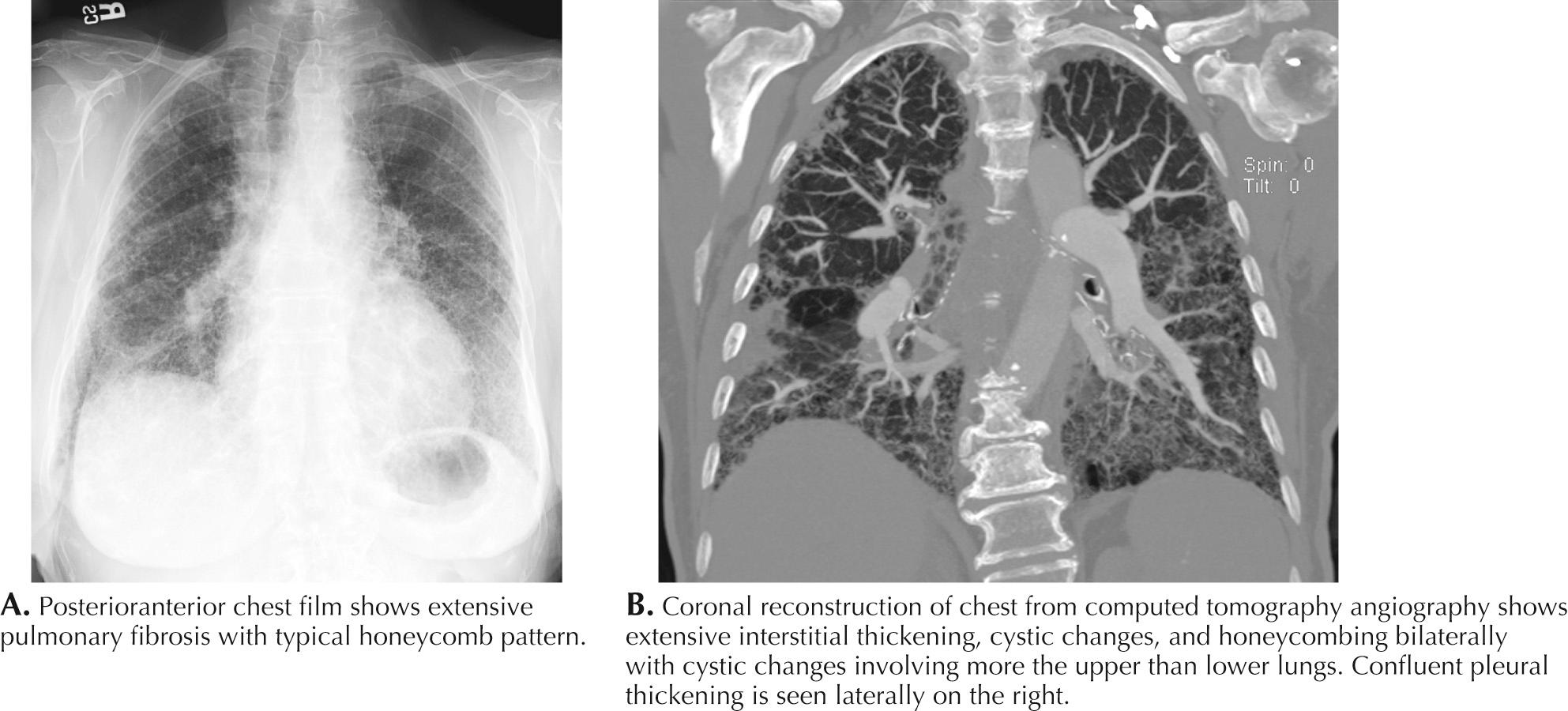
Sometimes polymyositis (PM) is associated with an underlying connective tissue disorder. In those patients, serologic markers for the underlying disease may be positive. These include antinuclear antibody (ANA) and/or rheumatoid factor. On occasion, the presence of these antibodies can aid in the diagnosis of the occasional patient for whom the history is not definitive. This is especially so when there is diagnostic confusion between the possibility of an acquired inflammatory myopathy and a genetically determined dystrophy. When PM and, less commonly, DM are associated with other collagen-vascular diseases, the combination is referred to as an overlap syndrome. Systemic lupus erythematosus (SLE), systemic sclerosis, rheumatoid arthritis, and Sjögren syndrome may have weakness as a component of their myriad symptoms and signs. In these cases, muscular weakness exceeds what arthritis alone can account for. They are characterized by elevated titers of anti–U1/U2-ribonucleoprotein antibodies, PM-Scl antibodies, or anti-Sjögren’s-syndrome-related antigen A (SSA) antibodies in scleroderma, Sjögren syndrome, SLE, or mixed connective tissue disease. DM is rarely associated with other collagen-vascular diseases, with the exception of scleroderma. sIBM is associated with underlying autoimmune disorder (e.g., SLE, Scleroderma, Sjögren) in up to 15% of cases.
Paraneoplastic antibody evaluation may occasionally be helpful in the differential diagnosis of proximal weakness. This is particularly so in patients with Lambert-Eaton myasthenic syndrome (LEMS) who often present with symptoms mimicking a myopathy. These individuals have elevated levels of voltage-gated calcium channel antibodies. This finding, in addition to the classic EMG nerve conduction studies typically seen in LEMS, is very specific for this diagnosis. In addition, anti-Hu antibodies may be positive in patients with myopathy associated with small cell lung cancer.
Immunofixation to look for the presence of serum monoclonal protein is necessary in certain instances if either amyloid myopathy or sporadic late-onset nemaline myopathy (SLONM) is in the differential diagnosis. Approximately 20% of patients with sIBM also have a monoclonal gammopathy of uncertain significance (MGUS). Appropriate endocrine evaluation is necessary in myopathic patients when a more obvious diagnosis is not apparent.
Vitamin D levels are also important. Rarely, hypovitaminosis D may present with a myopathy. Similarly, patients with primary or secondary osteomalacia may present with proximal weakness. Elevated serum alkaline phosphatase and low serum calcium values may point toward these under recognized disorders.
EMG evaluation of patients with suspected myopathies is important ( Fig. 71.4 , and see Fig. 71.2 ). Results of routine nerve conduction studies are normal in myopathies, with the exception of diminished compound muscle action potential amplitudes in more severe disorders. The primary EMG abnormalities in the myopathies are classically found at the time of the needle examination. Classic findings of a myopathy include the presence of abnormally low amplitude, short duration, and polyphasic motor unit potentials (MUPs). In myopathies, patients have both an early recruitment and increased numbers of MUPs early on in the muscle activation for a given effort. However, adding to diagnostic confusion, patients with chronic myopathies (e.g., sIBM) can sometimes have needle examination findings resembling that of a chronic neurogenic process. Destruction of myofibrils or muscle membrane results in abnormal insertional activity, particularly fibrillation potentials and complex repetitive discharges. Inflammatory myopathies, dystrophies, and myotonic disorders may be distinguished from neurogenic disorders by the presence of myotonic potentials on needle EMG.
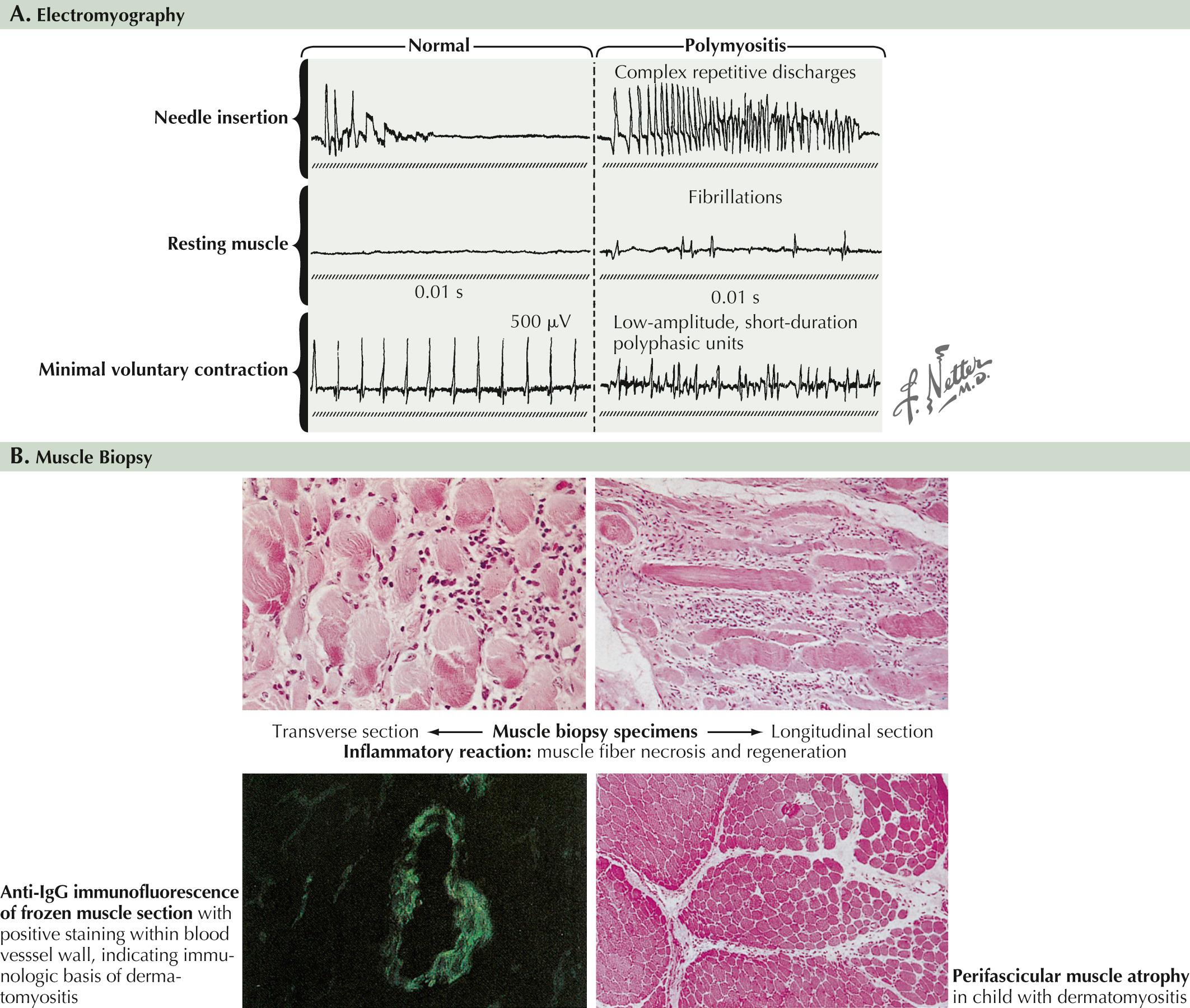
Concomitantly, EMG helps to exclude disorders that affect other anatomic sites within the peripheral motor unit, particularly those with symmetric proximal weakness mimicking a myopathy. These include motor neuron disorders, such as amyotrophic lateral sclerosis and spinal muscular atrophy type 3 and 4, CIDP, neuromuscular transmission disorders (particularly LEMS), and myasthenia gravis. Results of EMG are often normal in the various endocrine, mitochondrial, and congenital myopathies.
Magnetic resonance imaging (MRI) of muscles, in addition to EMG to look for signal change abnormalities, is useful in patients with inflammatory myopathies because it may highlight the pattern of preferential involvement (e.g., the quadriceps in sIBM) and may help in the selection of a diseased muscle that can be a potential biopsy site. MRI of muscles may also be helpful in certain patients in whom muscle biopsy is contraindicated.
Muscle biopsy is the definitive diagnostic tool for many myopathies ( Fig. 71.5 ). The selection of the biopsy site is important; muscles that are unaffected, that are severely affected and therefore likely to only show end-stage changes, or that have been recently subjected to needle EMG evaluation should be avoided. Muscles commonly biopsied include the vastus lateralis, deltoid, rectus femoris, and biceps brachii. The gastrocnemius muscle is often avoided due to the possibility of incidentally discovered neurogenic atrophy. The upper lumbosacral muscles, thoracic paraspinal muscles, such as the multifidus, and much less commonly the cervical paraspinal muscles provide alternative sites for biopsy.
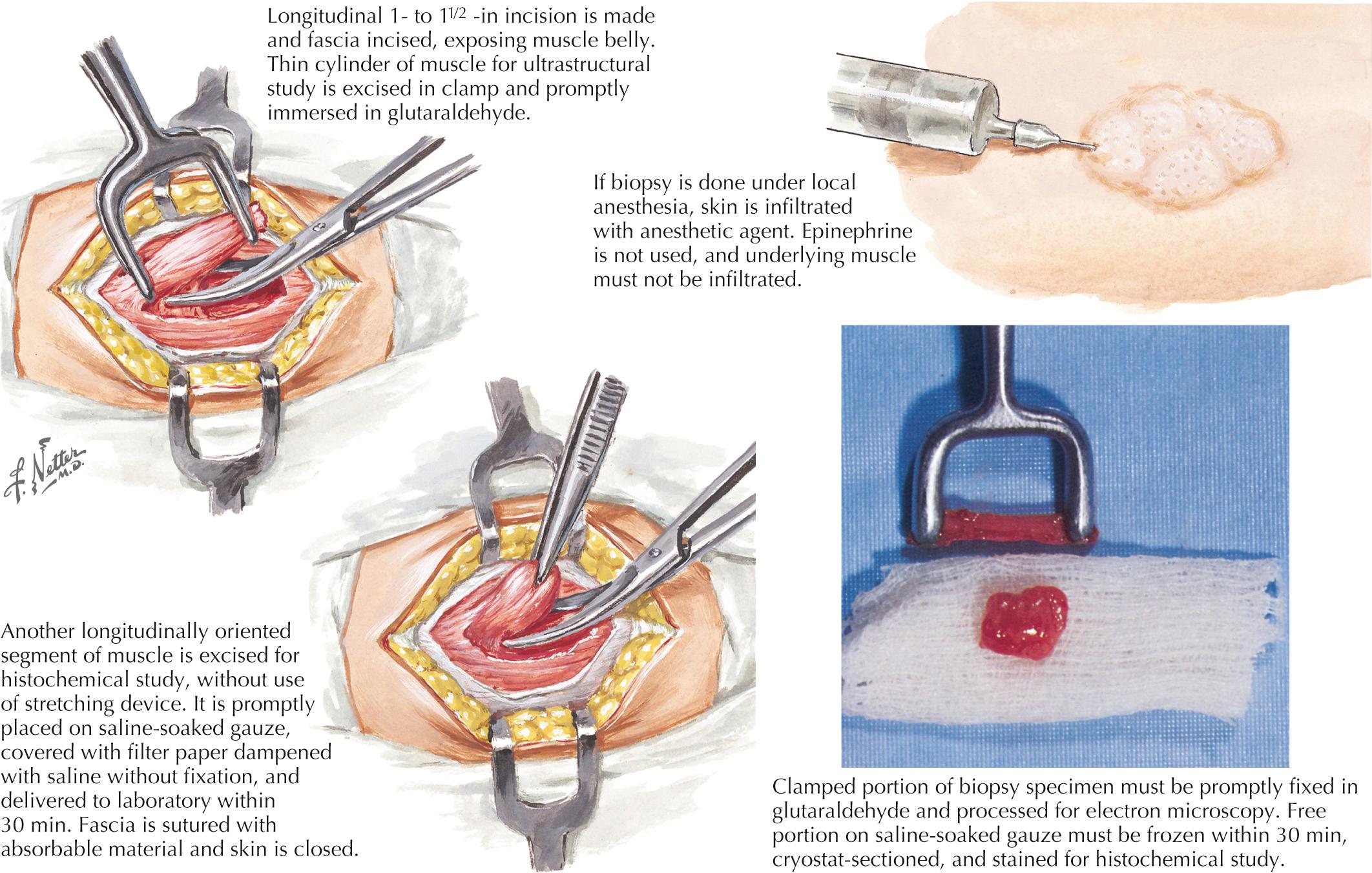
The muscle biopsy specimen is divided into separate aliquots for formalin fixation, paraffin embedding, and immediate freezing in isopentane cooled in liquid nitrogen. The formalin-fixed piece is stained with hematoxylin and eosin (H and E) because this permits a rapid means for initial evaluation. This is especially useful for identifying inflammatory myopathies where such a diagnosis offers the potential for successful therapeutic intervention. Frozen specimens are best for other stains, including nicotinamide adenine dinucleotide dehydrogenase (NADH), modified Gomori trichrome, adenosine triphosphatase, and lipid and glycogen stains ( Fig. 71.6 and see Fig. 71.4 ).
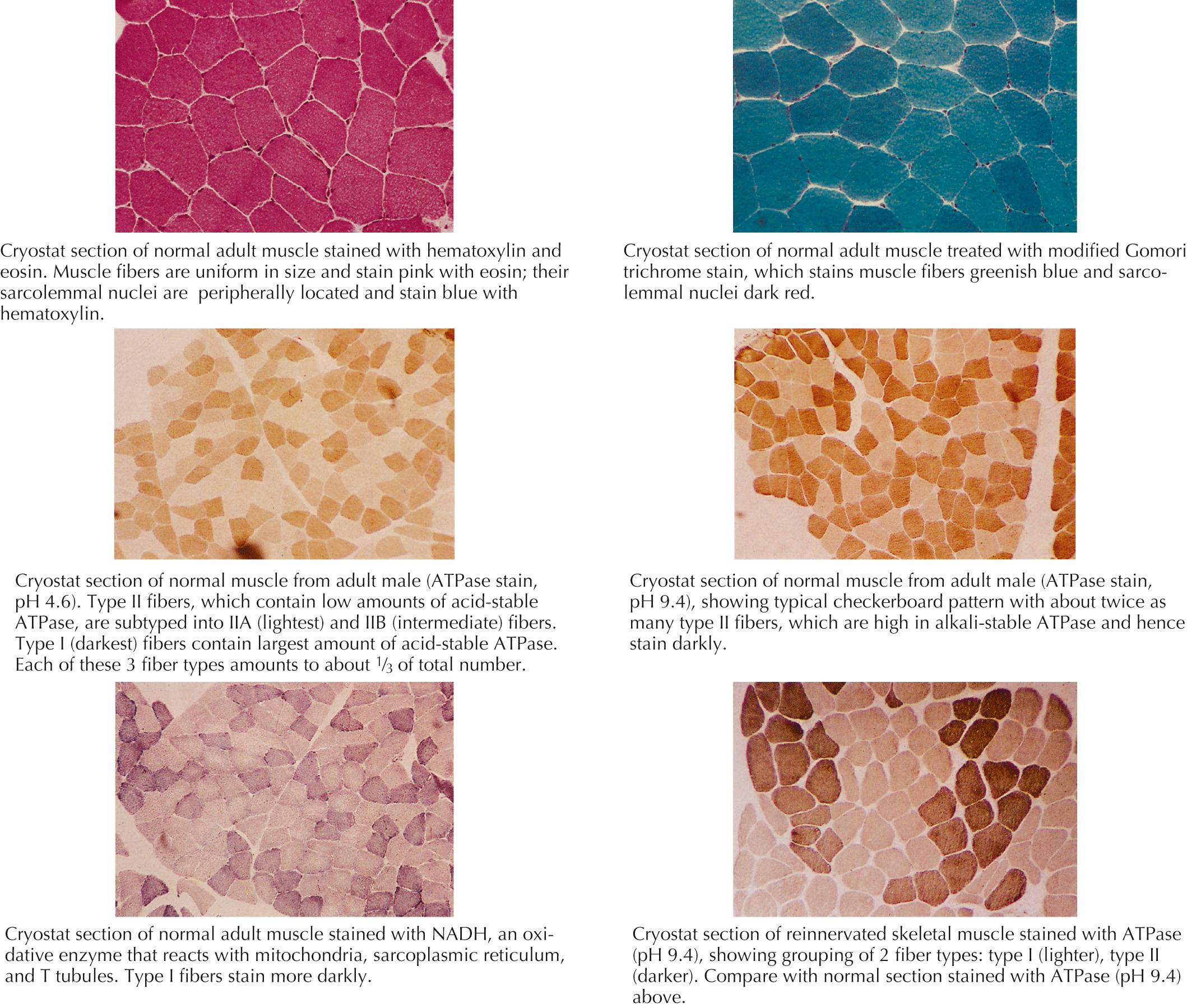
Muscle biopsy specimens are also subjected to biochemical analysis, mutational analysis, and electron microscopy (EM) when these techniques are indicated. Inherited myopathies, such as the various muscular dystrophies, are evaluated by immunohistochemical stains and immunoblotting; testing is available for calpain, caveolin, dysferlin, the dystroglycans, dystrophin, laminin-2 (formerly merosin), and the sarcoglycans.
There are three acquired inflammatory myopathies: PM, DM, and sIBM. Necrotizing myopathies are often classified with the inflammatory myopathies because they are immune mediated; however, they lack inflammation or have minimal inflammation on muscle biopsy.
This relatively uncommon inflammatory myopathy is seen mainly in adults and presents subacutely usually over a period of several weeks to a few months. Clinically, an important means for distinguishing PM from DM is the absence of skin involvement in PM. However, DM may also rarely present without skin involvement (sine dermatitis). Various criteria have been proposed to make a definitive diagnosis of PM. Usually PM patients present with symmetric proximal weakness, involving the upper and lower extremities. Mild dysphagia, myalgia, and systemic symptoms, such as polyarthritis, may accompany the weakness. Rarely, patients may present with either a clinically isolated head drop or respiratory muscle weakness. Acid maltase deficiency (glycogen storage disease type II) needs to be considered in those individuals presenting primarily with respiratory symptoms. The proximal and symmetric pattern of weakness in PM distinguishes it from the classic asymmetric regional pattern of weakness in sIBM. Historically, certain patients with sIBM were likely misdiagnosed as having PM; sIBM is more common than PM.
EMG is often abnormal and may show characteristic findings of myopathic motor units and increased insertional activity, with fibrillation potentials and complex repetitive discharges. Laboratory studies reveal an elevated CK level. Muscle biopsy demonstrates perimysial and endomysial inflammatory infiltrate with CD8+ T cells invading nonnecrotic muscle fibers (see Fig. 71.4 ). ILD can be seen in 10%–20% of patients with PM and may be associated with positive anti-Jo-1 antibody. Cardiac involvement (cardiomyopathy and congestive heart failure) is common, although the incidence of these associated conditions is unknown.
Become a Clinical Tree membership for Full access and enjoy Unlimited articles
If you are a member. Log in here